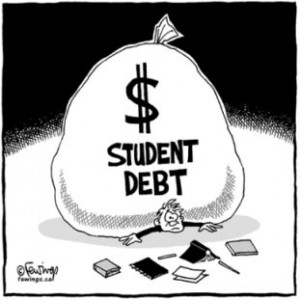We live in a country where the student debt is the second largest debt after mortgages. U.S is one of the nations where the education cost is outrageous and almost impossible to cover without taking any loans. The cost is so high, because it is purposely set up that way. Students are being offered loan programs, which allow the schools to increase the tuition each year. The higher the tuition, the better the school’s reputation – and we all know it. According to the article the “average student loan balance for a 25-year-old is $20,326.” For most of the young adults, it takes until middle age to pay off the student loans. But is it all worth it? A huge number of students have difficulties finding a job after graduation or are being terminated after a short period of time. Bennett looked at the 3500 colleges and universities in the U.S and calculated the return on investment. The results were a bit shocking. Only 150 institutions had a positive return. The top 10 (ranked by Bennett) are listed below:
- Harvey Mudd College
- California Institute of Technology
- Massachusetts Institute of Technology (MIT)
- Stanford University
- Princeton University
- Harvard University
- Dartmouth College
- Duke University
- University of Pennsylvania
- University of Notre Dame
Bennett said “college is worth it if you get into a top tier university like Stanford, or study an in-demand field like nuclear engineering at even a lower tier school.” Not everyone can afford to go to Stanford.
I somewhat agree with Bennett’s point of view, since the top companies only retain talent from the ivy league schools. Some organizations will not consider inviting you for an interview, if you didn’t go to a top university. I believe everyone deserves a chance, and school should not be the only factor that impacts your future. However, we live in a society where the “brand name” matters the most. Universities compete with each other by establishing a good reputation. In result, students pick the schools that will guarantee a job in the future. The vicious circle closes. In order to create some equilibrium, universities that are less expensive should implement a breakthrough improvement. As we learned in class, innovation and creative thinking is crucial. Also, such schools should use the benchmarking method. By researching the industry and following the footsteps of the successful colleges it will lead to a superior performance. It will give them a chance to become more popular, and hopefully, a positive return on investment ratio for the students. I think more students are willing to go to a more affordable college, where the future outcome is bright.
Unfortunately, this is not the case. As I mentioned before, the more you pay for your tuition the higher chances of getting a job. The question remains – is this fair?
Links where I found the article and the pictures used for this blog:
http://finance.yahoo.com/blogs/daily-ticker/only-150-3500-u-colleges-worth-investment-former-132020890.html?vp=1
http://www.mynextcollege.com/college-life/the-student-loan-scam/
http://www.sfexaminer.com/files/blog_images/graduationhats.jpg
http://www.blackenterprise.com/career/10-highest-paying-college-degrees-for-african-americans/attachment/grad-cap-money-620×480/

